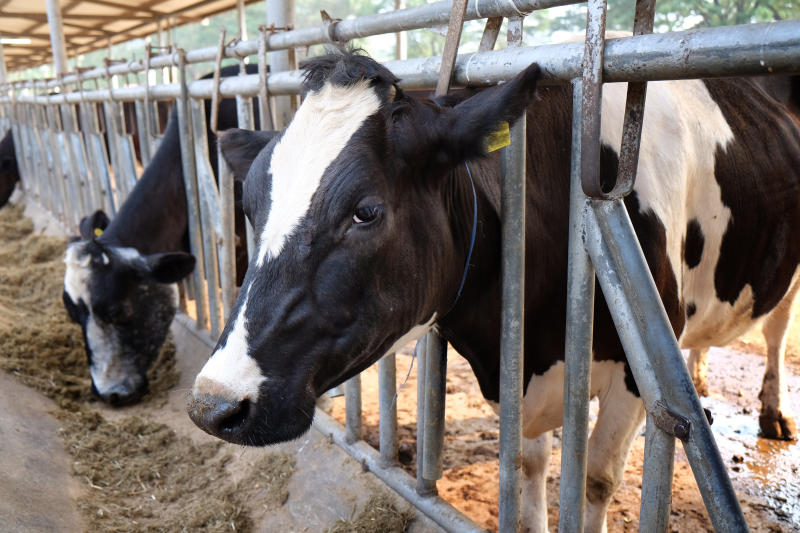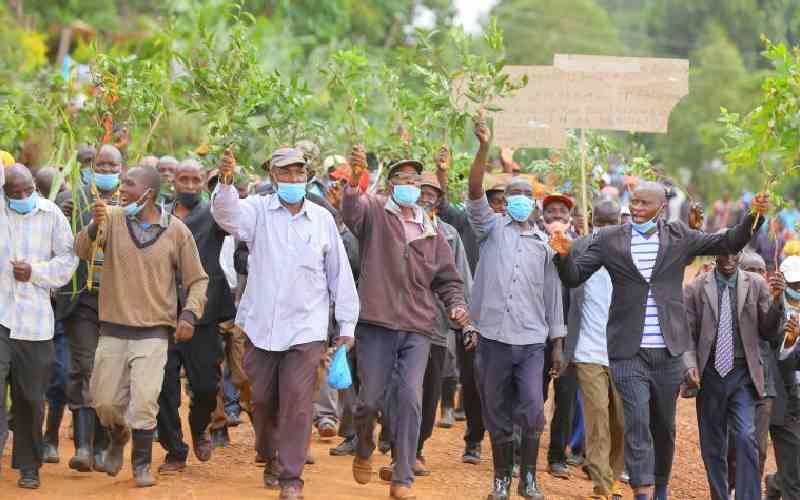
Bernard Ronoh has been a dairy farmer long enough to witness both good and bad days in the sector.
When he started off with four friesian cows in 2015, dairy farming was a lucrative venture that fetched farmers Sh35 on a litre of milk.
He supplied milk to a local milk processor that paid farmers every month.
It was from this amount that Ronoh bought mineral supplements for his cows.
But last year, farmers were hit with a plunge in milk prices when they started selling the commodity at Sh25 a litre.After that Mr Ronoh stopped giving his cows special attention.
“I started buying low quality salt lick for the cows since I couldn’t afford the good quality one. I gave them dairy meal only once in a while and in turn, I saw the drop in their milk production,” says Ronoh adding that he now gets only 20 litres of milk from the cows because he can’t afford to feed them properly.
This year, dairy farming in Kenya took a turn for the worse when milk prices dropped further in the seemingly crumbling milk sector.
Today, farmers get as low as Sh16 on a litre of milk against the Sh30 they spend on production of a similar amount of milk. In fact, it was alleged last week that frustrated farmers in Nyandarua threw away their milk in a protest against the poor prices.
They were protesting against imports of cheap milk that they said had flooded the Kenyan market as well as oppression from local milk processors that offered farmers low prices while they fetched a tidier sum from milk products.
“We want the imports stopped. We also appeal to the regulators of the dairy industry in Kenya to intervene in the prices that milk processors are offering us. This is the only way to address our challenges,” said Ronoh.
But Dr Michael Wawire, a lecturer at Jomo Kenyatta University of Agriculture and Technology (JKUAT), department of Food Processing and Food Engineering says milk processors are not the cause of the challenges facing farmers. According to the JKUAT don, local milk processors buy a negligible amount of the milk produced in Kenya.
The real problem
“We do about 5 billion litres of milk in Kenya every year. Processors can only take about 10 per cent of the total amount of milk produced while the rest is processed by small scale farmers and farming groups,” says Dr Wawire.
Neither is milk imports the problem, according to Dr Wawire.
Stay informed. Subscribe to our newsletter
Kenya is producing 5.6 billion litres of milk every year and imports nearly 120 million litres from the East African Community (EAC) member states and 2 million litres from non-EAC members. This accounts for only 2 per cent of milk imports on the Kenyan market.
And Dr Matthew Gicheha, a lecturer at the JKUAT department of Animal Sciences says the plunge in milk prices is an indicator of how the economy is doing badly.
“Locally produced milk is consumed on the ground through direct farmer-to-farmer engagement and only a little percentage gets to the processors. The fact that there is excess milk in the market indicates a drop in the purchasing power of households. People don’t have money to buy milk,” says Dr Gicheha.
He says the challenge isn’t isolated to Kenya.
“The plunge in milk prices is a global challenge. There have been reports of dairy farmers in Europe pouring their milk away in protest against low prices,” says Dr Gicheha.
Structured value addition options
“Even as we urge farmers to embrace value addition, we recommend structured processes. Otherwise, everyone will be producing yoghurt in their backyards with no one to buy it,” says Dr Wawire, an expert on value addition.
Get into groups
So what to do with such a grim scenario?
He encourages farmers to form groups to pool their resources together before they start processing their own milk. These groups should be registered with counties for ease of operation.
Researchers at the JKUAT Food Technology Centre (FOTEC) conduct short course training in food processing and value addition for women and youth groups, SMEs and other individual farmers.
There are two fully equipped food processing centres where various food products are produced and marketed.
Some popular products include different flavours of yoghurt, juices, jams and baked products such as bread, scones, buns, cakes and doughnuts.
Dr Wawire says JKUAT has signed an MoU with at least 30 counties to offer expertise and technical assistance to farmers looking to venture into value addition.
“Farmers groups from all the 30 counties we have an MoU with, can always come to the food technology centre with their milk, use our equipment and experts to make their milk products and walk away with them. This can help them cut the cost of purchasing equipment.”
The university also manufactures affordable farm equipment for farmers looking to venture into value addition. Fabricated value addition equipment at the university includes pasteurisers, milk incubators and coolers.
Value added milk products have a longer shelf life. Maziwa lala, for instance, can take months before going bad, according to the JKUAT researcher.
“To make maziwa lala, you don’t even need a fridge to store it. The milk has several months of shelf life,” says Wawire.
He urges farmers to look for opportunities in school feeding programmes where they can sell their maziwa lala.
Get rid of expensive cattle
There are different breeds of dairy cattle a farmer can choose from. The most common types in Kenya are the Friesian, the Ayrshire, the Jersey and the Guernsey. All these are varied in terms of their production as well as their cost of rearing.
While the Friesian produce up to 60 litres of milk every day, these cows are heavy feeders, consuming more than 100 kilos of fresh forage per day. The Guernsey which produces about 25 litres in a day, on the other hand, is a moderate feeder, requiring as little as 60 kilos of forage in a day. The Guernsey is also hardier compared to the Friesian.
Dr Gicheha, an animal production expert at JKUAT, urges farmers to invest in moderate cows which aren’t too expensive to maintain. He likens buying dairy cows to investing in a car.
“Cows should be like cars. If you buy a Mercedes and fail to service it, it will crash,” says Dr Gicheha.
He adds: “Everyone wants to buy a Friesian because they are told it gives a lot of milk. But it consumes a lot of feeds and susceptible to diseases. In the end, the cow becomes too expensive to manage. I urge farmers to just invest in moderate cows and let go the expensive ones.”
Invest in simple feeding technologies
The biggest challenge to dairy farmers is the high cost of feeds especially for those doing zero grazing.
A spot-check by Smart Harvest found that a bale of Rhodes grass weighing 10 kilos costs Sh300. A farmer rearing four Friesian cows spends up to Sh3,000 on hay alone. Additionally, they spend on dairy meal, supplements and labour. Some farmers, like Ronoh, have cut on these costs by growing their own grass.
Another strategy is to stock up when there is plenty, says Dr Gicheha.
“While it rains, there are lots of pastures and we hope farmers are keeping enough silage to use when the rains disappear. This is time to dig pits and store the silage to avoid buying when the pastures dry up,” he says.
 The Standard Group Plc is a
multi-media organization with investments in media platforms spanning newspaper
print operations, television, radio broadcasting, digital and online services. The
Standard Group is recognized as a leading multi-media house in Kenya with a key
influence in matters of national and international interest.
The Standard Group Plc is a
multi-media organization with investments in media platforms spanning newspaper
print operations, television, radio broadcasting, digital and online services. The
Standard Group is recognized as a leading multi-media house in Kenya with a key
influence in matters of national and international interest.
 The Standard Group Plc is a
multi-media organization with investments in media platforms spanning newspaper
print operations, television, radio broadcasting, digital and online services. The
Standard Group is recognized as a leading multi-media house in Kenya with a key
influence in matters of national and international interest.
The Standard Group Plc is a
multi-media organization with investments in media platforms spanning newspaper
print operations, television, radio broadcasting, digital and online services. The
Standard Group is recognized as a leading multi-media house in Kenya with a key
influence in matters of national and international interest.









